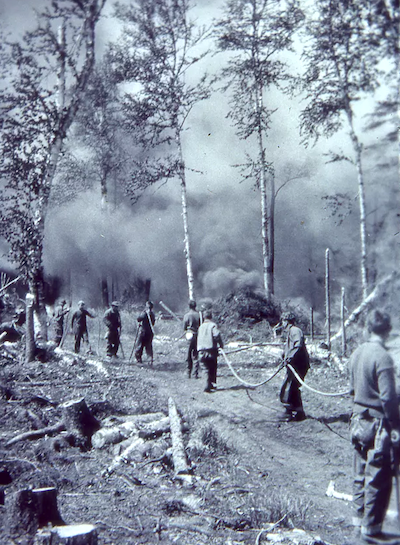Editor's note: The stated mission of the Civilian Conservation Corps was a work relief program to put unemployed young, unmarried men to work on public lands, but it also combined funds and manpower to perform needed projects in the National Park System. In many instances, CCC crews gained skills by cutting trails and building structures in existing units of the system, but in other cases they helped bring parks into the system. This is the second article in an occasional series that highlights some of the work of the CCC in the park system.
When the first Civilian Conservation Corps crews arrived on Isle Royale in 1935, the understanding was that the young men would help transform most of the island into a national park. Along the way, they got a quick course in firefighting.
"The CCC spent the summer months constructing buildings, housing, docks, and campgrounds. Simultaneously, the Consolidated Paper Company was logging balsam fir and spruce pulpwood from their holdings on the island," the National Park Servie notes on the park's website. "The summer of 1936 was hot and dry. Temperatures were far above average. A drought was being felt across the northern Midwest, and Isle Royale was no exception. On July 25, 1936, a fire started at or near the location of the Consolidated Paper Company’s lumber mill camp on Siskiwit Bay, and both the CCC enrollees and the loggers would find themselves battling a blaze."

CCC crews on the fire lines/NPS archives
Zachary T. Phillips recalled in a journal he kept that "the drought conditions were acting as a huge vacuum, pulling every possible ounce of moisture from the coniferous forest. The nightly combustible slash left on the ground by a logging company was also being rid of its precious moisture, leaving the area in a (sic) explosive fire situation."
"Anyone with a first-hand knowledge of what an area looks like after clear cutting balsam fir and white spruce can quickly visualize how easy it would be or a fire to start and how rapidly it would spread once started," he wrote. "The cause of the fire was never definitely determined, but it is believed to have been started by a careless camper. Immediately after the fire was reported the two camps of Civilian Conservation Corp enrollees that were already on the island were called into action."
This was no small fire. Within five days the blaze, dubbed the Greenstone fire for a ridge it went up and over, had grown to more than 4,000 acres. Before it was put out, it covered some 27,000 acres on the island. To help battle the flames, 400 CCC crews were ferried over to the island. Within weeks, some 1,600 CCC workers manned the fire lines.
"The fire reportedly burned with such intensity on the night of July 31 that reflections could be seen over 40 miles away on Michigan's mainland. On August 1, the blaze began to threaten the CCC and lumber camps. However, with the addition of 400 CCC reinforcements arriving from the mainland, the camps were able to be saved, along with 100,000 dollars worth of lumber," the Park Service recalls.
Conditions for the CCC crews were, to put it mildly, wanting.
"There was a definite lack of camp and food sanitation. Flies accumulated around the camp by the millions and very often while eating, a well cooked fly or flies made their appearance, mixed in with the food," said F.T. Priester, the acting fire boss at Gull Rocks Camp. "This can be excused occasionally, but not every day. I can safely say that it was the dirtiest, most unsanitary, most foul smelling camp that I have ever worked in."
After tobacco for the CCC crews ran out on August 20, the men went on strike five days later.
"That afternoon, tobacco was promptly brought in, and the firefighters withdrew their strike," the Park Service said.
It wasn't until mid-September that the fire was brought under control, and that was in large part due to rain and cooler weather that set in over the island, according to agency records.
"However, by this time the fire had consumed 20 percent of Isle Royale's forests," the Park Service said. "After the fire was out, work was resumed on national park projects. The CCC enrollees normally did not spend winter on the island, but during the winter of 1936-1937, 115 CCC recruits volunteered to stay in order to clear remaining fire hazards."
Ben East, the conservation editor of the Grand Rapids Press at the time who spent three days on the island watching the firefighters, said, "I'm not in any sense a trained firefighter, but I do know 'guts' . . . and the CCC lads on Isle Royale have 'em."
Edward J. Shuster, who at one point was a Camp Education Advisor for the CCC, would add that, "Neither the heat of hellish holocaust of burning forests, not the long fatiguing work, and waiting stopped them. Not the flaming horizon with its crimson heat singeing the very skies, nor the dreary moisture of cold nights could lick them.”
Over the next six summers, CCC crews built "Park Service administrative buildings, employee housing, recreational facilities, and also worked on trail development, the construction of docks, campgrounds, fire towers, and day markers that were used as navigational aids. Additionally, the recruits conducted wildlife surveys, caught island moose for mainland repopulation projects, and fought forest fires."
Isle Royale National Park was officially established on April 3, 1940, and the last CCC camp was disbanded in September 1941.


